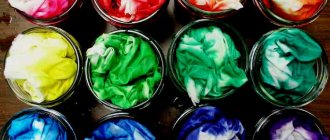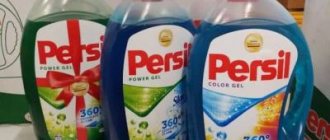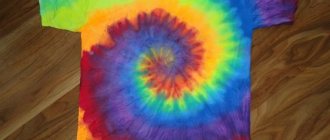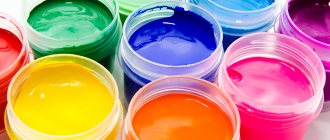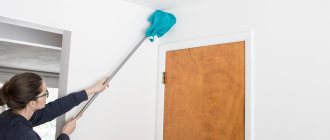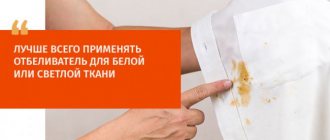Main types
There are several types of paints intended for coloring or decorating. Modern fabric paints are hypoallergenic, easy to apply to the product, adhere well, and excess is washed off with water.
For coloring
You can change or restore color using aniline or natural dyes. Clothes made from natural fabrics (cotton, linen, viscose) or with the addition of up to 50% synthetic fibers are suitable.
Aniline
Used for dyeing clothes made from natural, semi-synthetic fabrics, wool, leather, fur. Does not affect lavsan, nitron. Available in powder and liquid form. The color changing process is performed in a washing machine or manually at a temperature of 30-40⁰C. Using the hot method, items with a dye solution are gradually heated to 95⁰C.
Natural
Use infusions with natural ingredients (onion peels, juices of vegetables, berries, fruits, coffee, tea). This coloring is environmentally friendly and has delicate color shades.
The process is similar to painting with aniline dyes, but the solution is heated to 50-60⁰C. Next, fix the pigment for 25 minutes in a 1% solution of potassium aluminum or ferric ammonium alum. Rinse in a weak vinegar solution.
For decoration
Different compositions and forms of paints are convenient to use for painting on clothes in a variety of techniques (drawing, stencil, stamp).
Acrylic
The paint is made from odorless paint components and is suitable for any materials and surfaces. The colors are bright, rich, and do not fade. They dissolve well in water, so it is easy to create shades for drawings. While the surface is damp, bad moments can be washed off with water. Available in cans, tubes, jars and stored at temperatures above 0⁰C.
Acrylic paint for clothes is applied with a brush to an image made with a pencil or a special marker. Using a clear or black outline, you can create smooth edges of the image. For fixation, the dried pattern is ironed under a layer of paper or from the inside of the product.
Dye
Decoration example
You can use a marker or brush for application.
Aerosol
To make a drawing using the stencil technique, spray paint is suitable. It fits well and is easy to use. It is used only for decorating clothes, as the fabric with it becomes stiff and does not stretch well.
Stages of work
- A film is placed inside T-shirts and undershirts so as not to stain the back of the product;
- Lay out the stencils;
- The can is shaken;
- Holding it vertically, spray at a distance of 5-6 cm (when applied close, the quality of the decor changes).
After 40 minutes, the drawing dries and is fixed.
We put film under clothes
Laying out the stencils
Apply paint
Glowing
Reflective paint can be applied to all types of cotton items. Adult and children's clothing with an image that glows in the dark or under the influence of ultraviolet radiation looks impressive. The paint contains phosphors (powder with colorless varnish). In the daytime it is white or colored, in the dark it glows blue, green, yellow.
Dyeing technology
After the preparatory activities, they proceed directly to painting the products. According to the instructions, dilute the paint in a small container, stirring the solution well. Then it is filtered and sent to a container for coloring, adding the required amount of water.
After painting, the material must be thoroughly rinsed and dried.
The solution is heated over a fire and the product is immersed in it. To obtain uniform dyeing, the fabric is rotated in a circle using wooden sticks. As soon as the item acquires a color slightly darker than desired, it is removed from the solution. The shade will become lighter as it dries.
If it is necessary to obtain streaks when painting, then the product is twisted and fixed in this state with rubber rings. In this form it is immersed in dye.
After the item is removed from the solution, it is rinsed in clean water several times until the liquid becomes clear.
Important! Drying painted items is not recommended in the sun or near a stove.
A huge selection of formulations can lead consumers to confusion. To choose the right composition, you must first select the dyeing technology and type of fabric. After that, reading the instructions, select the desired option.
Select by fabric type
Depending on the composition, the painting features and the result change:
- Natural cotton, linen or semi-synthetic fabrics can be dyed well at home. The maximum amount of synthetic fibers in the material should not exceed 50%. The more synthetics, the lighter the finished shade;
- Synthetic fabrics are not dyed or dyed unevenly, with spots;
- Silk and viscose are dyed in cool water, gradually heating to almost boiling;
- Wool, leather, fur are suitable for painting.
There are several types of paints for dyeing and painting clothes on the market.
Simplicol
This is the name of German paints, characterized by a rich range of colors and high quality of color fixation in one step. Simplicol is intended for different materials:
- Natural fabrics in warm water;
- Silk, coarse types of wool, polyamide in hot water above 60⁰С;
- Underwear made of nylon, perlon (high temperatures produce rich colors, low temperatures produce delicate colors).
Universal paint "Tekhnokhim"
Dye made in Russia. Effective on linen, cotton, viscose, silk materials, as well as on fabrics with an unknown composition. The color is bright, juicy, and preserves well.
Dylon
They dye tulles, clothes made of silk, cotton, linen, and wool. Perfect for hand coloring, even without heating. Following the instructions, you will get a rich shade. To preserve it, the item is rinsed in a weak vinegar solution.
Dylon
Javana
Used for painting silk and synthetic items. Elegant decoration is done with a thin brush, and voluminous decor is done with a sponge or aerosol can. Fix the design with a hot iron, ironing it from the wrong side for 3 minutes.
JAVANA
Jacquard
Used for decorating textile materials. The acrylic composition is diluted with water, penetrates well into the fibers, colors evenly, and attracts with a variety of colors.
Popular paint manufacturers
Manufacturers of acrylic paints:
- "Decola";
- "Delon";
- "Simplicol";
- "Marabou";
- "Pebeo";
- "Javana";
- "Gamma";
- "Pigment Acrylic";
- "Surf";
- "Ideal".
Lumier has gold and silver dyes that give a metallic effect.
St. Petersburg Decola paints are the most popular among batik artists. Sold individually and in sets. Additionally there are brushes, solvents, contours. The average cost is 110 rubles per 50 ml jar.
- French manufacturer. Their textile dyes are easy to use and safe. An additional assortment is represented by brushes, solvents, and stencils. The average cost is 300 rubles per 45 ml jar.
German offers a wide range of products. They have a lot of pigments of different colors, brushes, applicators, stencils. Pigments are convenient for drawing small details. To fix the color, just iron the item with an iron. The average cost is 70 rubles per 20 ml jar.
The pigments are suitable for coloring natural and synthetic materials. They are easy to use, even when painting by hand. Gives a rich color. The average cost is 70 rubles per 20 ml jar.
Screen printing inks are water-based. Light colored material should be dyed. The average cost is 130 rubles per 50 ml jar.
Preparing clothes for dyeing
Preliminary preparation of clothing is necessary for uniform coloring of the product. If you have no experience in painting, it is advisable to experiment on old things, a piece of similar fabric.
How to prepare for painting:
- Clothes are washed and stains are removed as much as possible. Rinse without rinse aid;
- Study the label, determine the composition of the fabric;
- Weigh and turn inside out;
- To make the product better dyed, soften the water by adding salt;
- For manual painting with heating, use an iron container, place a board on the bottom so that the clothes do not burn, and stir with a wooden spatula.
On the packaging, manufacturers indicate the weight of items recommended for dyeing. If it is higher, then the amount of coloring composition is increased or the items are divided into two batches. Buy paint several shades darker than the original color of the items; light fabrics dye well, but less intensely. The brightness of the finished product depends on factors:
- Fabric composition (the more synthetic fibers, the lighter the shade);
- Initial color (light products - lighter, dark ones in tone - richer color);
- Painting time (the longer the period, the brighter the shade);
- Gradual heating and stirring (the longer, the richer the color);
- Complies with the weight recommended on the packaging.
The fabric around the decorative elements may not be dyed; if possible, they are removed. When sewing new things, first unrip the product, then there will be uniform coloring. Thick, woolen items are ripped in 3-4 places so that the dye penetrates well.
Washing clothes
Studying the type of fabric
Turn inside out
Add salt to water
We dye clothes in a metal container
Preparatory work
The first step is to prepare the fabric to be dyed. It must be clean and free of stains darker than the paint it is being repainted with. If any are present, they need to be removed with a stain remover.
Important! If the stains cannot be removed, then you need to choose a shade of dye darker than the stains themselves. For example, black fabric dye.
You might be interested in how to sew a beautiful fabric flower yourself as a decoration on a dress
Before dyeing clothes you must:
- make sure there are no metal objects on it, such as buttons, zippers, etc.;
- it is necessary to remove starch from new items made of cotton and linen by washing them first;
- woolen products are rinsed in a solution of water with ammonia - add 2 tbsp per 12 liters. l. respectively;
- Skeins of yarn are tied in several places so that the threads do not get tangled.
At the next stage, prepare the container for painting. Take clean dishes, preferably enameled ones. Galvanized or aluminum vessels can be used, but all traces of scale must be removed from them before the process begins. The volume of the container must correspond to the size of the item being painted. It should be completely immersed in the composition and not wrinkle. Otherwise, there is a possibility of getting an unevenly colored item.
For painting you need to prepare a deep container and a wooden stick.
Wooden sticks are used to turn things over. Their surface should be smooth without knots so as not to damage clothing.
Use soft water. It is better if it is rain or melt water. If there is none, then the hardness can be reduced by adding 1 tbsp. l. soda per 12 liters of liquid.
How to take better care
The quality of painting at home differs from that in a factory, so more careful care of clothes is required.
Tips on how to keep your coloring longer
- The first few washes should be carried out separately, as the paint may come off intensively;
- Use washing powder for colored items;
- Wardrobe parts painted with acrylic paints should be washed by hand at a temperature not exceeding 40⁰C;
- Rinse after washing to fix the color separately by adding vinegar to the water;
- Dry in the shade (the product will fade when exposed to sunlight).
Modern ideas for dyeing clothes allow you to create new creative images of your favorite things at home. A little imagination, desire and creative experimentation will delight you with its interesting results.
Product benefits
Advantages of acrylate water-emulsion mixtures:
- brightness and richness of colors;
- resistance to abrasion and ultraviolet radiation;
- quick drying (may cause discomfort if you lack skill);
- wide price range (materials are available for any financial opportunity).
To obtain a high quality acrylic polymer layer, you should know in advance how to use acrylic paints for fabric, and also take into account:
- fabric type and paint viscosity. Mixtures that are too thick are not suitable for thin materials. When applied, they will significantly reduce the mobility of the fabric and worsen its initial properties;
- fixation method. Acrylic paints, after drying, are usually fixed with an iron. It is necessary to maintain the optimal temperature conditions for processing, not forgetting about the permissible temperature values when ironing for each type of fabric;
- maximum proportions of solvent and paint - an overly diluted composition “floats” on the surface and is carried beyond the boundaries of the designated contours. Thick paint worsens the mechanical properties of the fabric and wipes off faster.
Next, we will talk about how much acrylic paints for fabric cost and where you can buy them.
The following video will tell you how and with what to dilute acrylic paints for fabric:
Cons and limitations
Acrylic paints cannot be called a one hundred percent widely used finishing material. Despite the fact that they are popular in various fields of activity and handicrafts, there are limitations to their use.
Types of things you should not paint on with acrylics:
- Bed sheets. Repeated washing will quickly fade and erase the design.
- Personal underwear. There is a possibility of an allergic reaction.
- Children's things (for children of kindergarten age). There is the same danger of allergies.
- Any textile, knitted or woven products that are dry cleaned. The drawing will simply be ruined.
Over time, the acrylic coating deteriorates (wears off, cracks). Without contours, paint often bleeds. Sometimes it is difficult to achieve the desired shade when mixing paints.
Factory-made bed linen with patterns made from acrylic paints is made using special technology Source selcdn.fedsp.com
Factory-made children's clothes are decorated with acrylic paints using special technology Source livemaster.ru
Material cost
You can purchase acrylic paints at numerous places that sell art materials, as well as fabric stores. Paints are sold individually or in whole sets, providing the required palette.
- The price of one bottle of acrylic paint for fabric with a volume of 50-70 ml is 50-150 rubles. The performance advantages of more expensive foreign products may not be noticeable on every painted product.
- The cost of an aerosol can reaches 400-600 rubles. It should be taken into account that the volume of the pressurized cylinder is larger than that of a regular bottle of paint and can range from 100 to 200 ml.
Acrylic paints for fabrics are popular due to their ease of application, durability and lack of toxicity. Using aerosol compositions, you can reproduce strict patterns or thematic signs with minimal skill. Acrylic paints for painting on fabric allow you to realize your wildest fantasies, making clothes more colorful and your style more extravagant.


